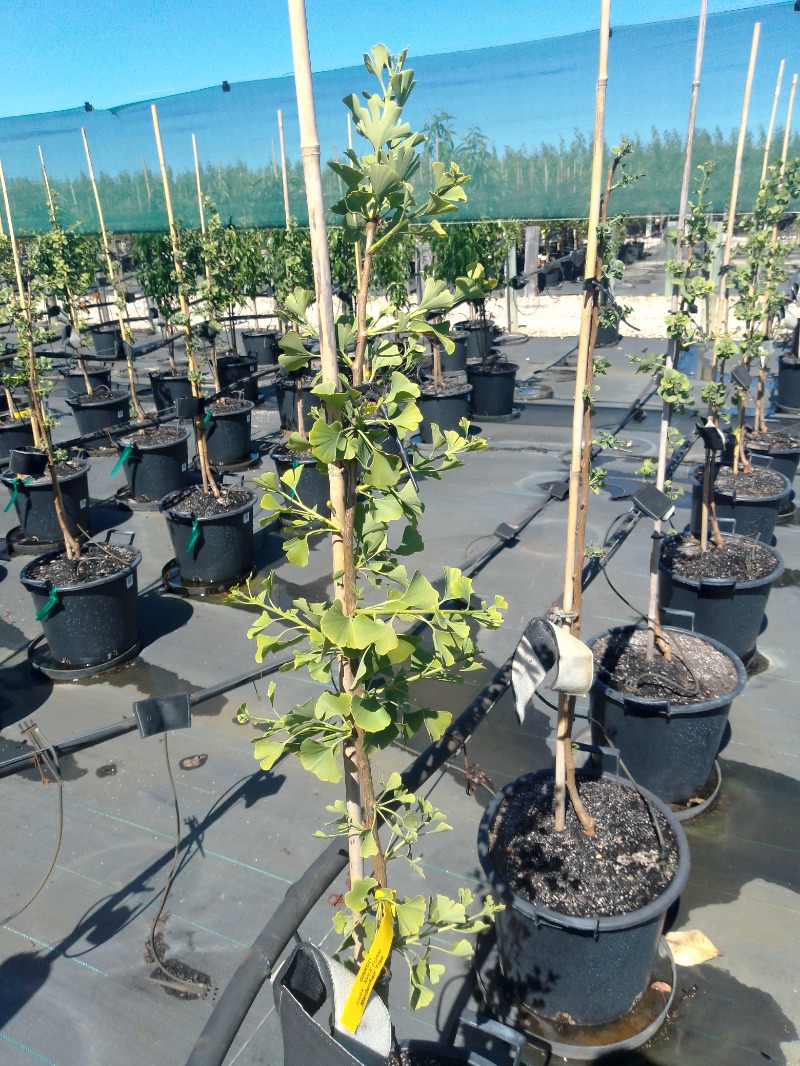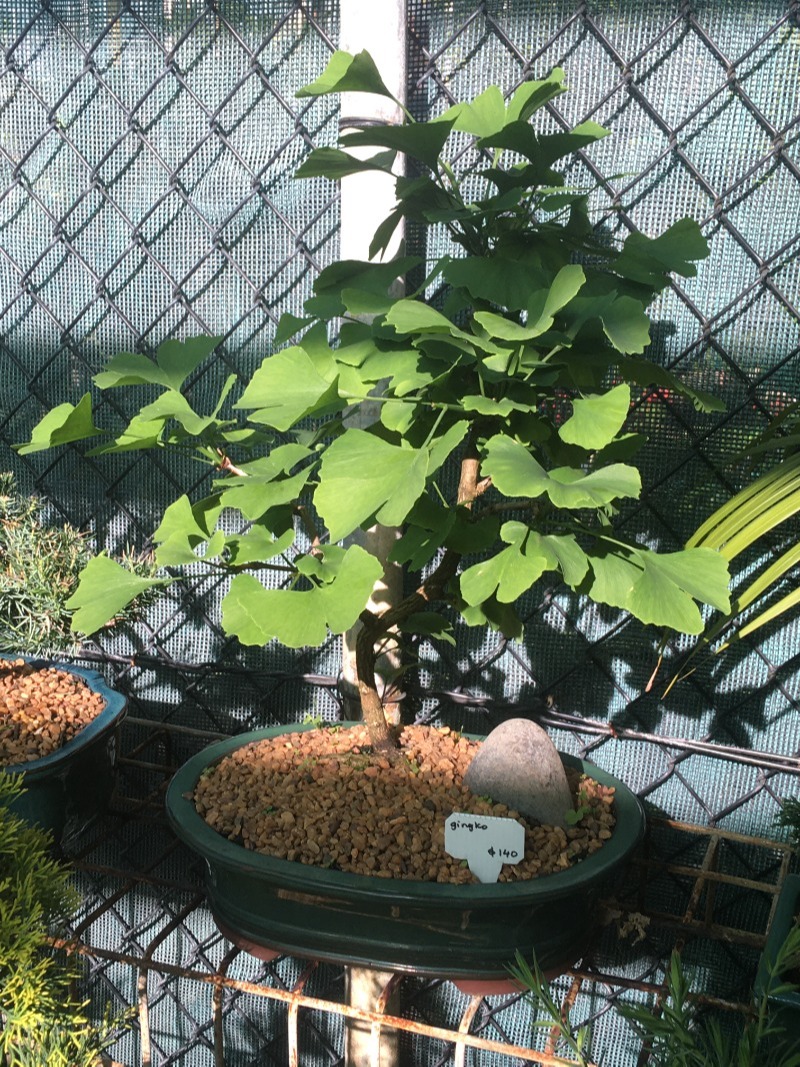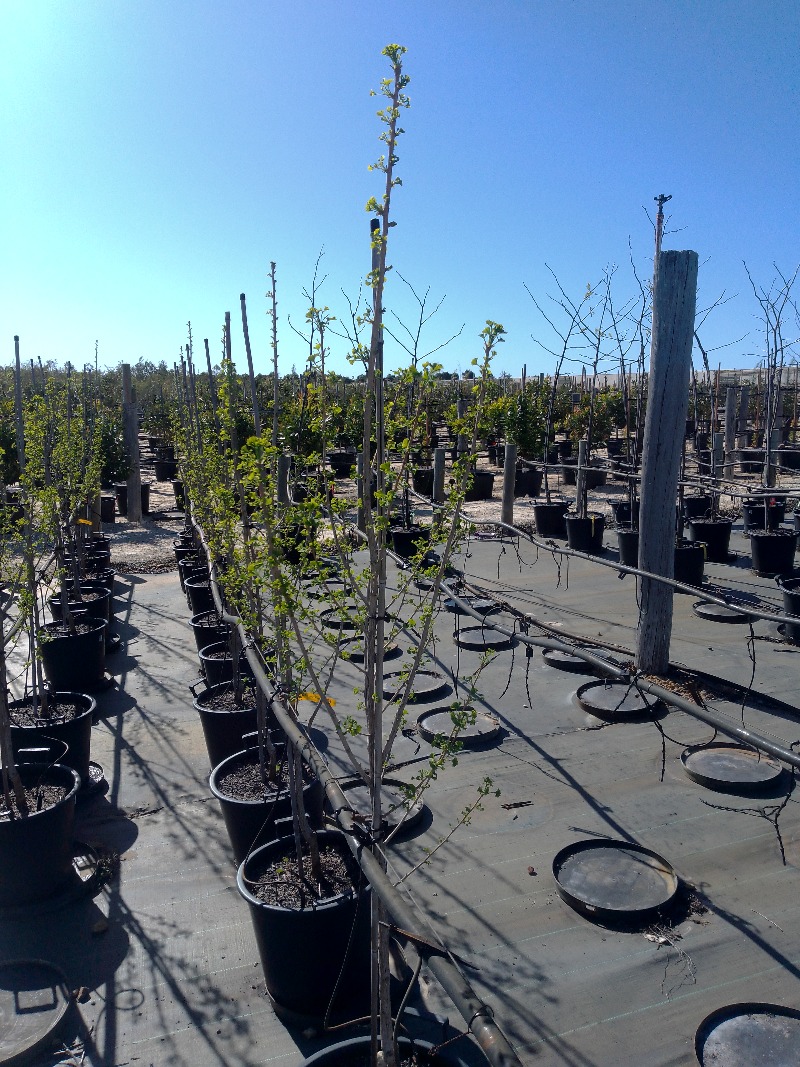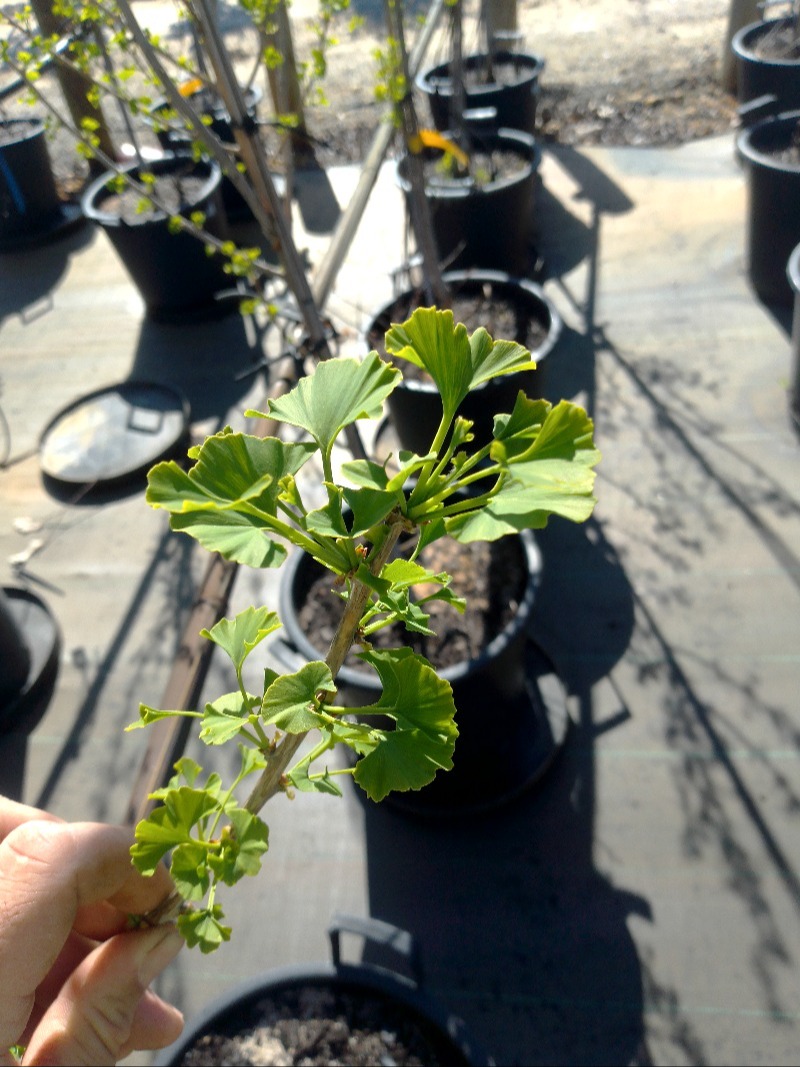Ginkgo biloba L. (1771:313)
Ginkgo, Maidenhair tree, Bai Guo, Yinxing
Taxonomy & Nomenclature
Homotypic synonyms (taken from POWO, 2023):
Pterophyllus salisburiensis J.Nelson in Pinaceae: 163 (1866), nom. illeg.; Salisburia adiantifolia Sm. in Trans. Linn. Soc. 3: 330 (1797), nom. illeg.; Salisburia biloba (L.) Hoffmanns. in Verz. Pfl.-Kult.: 109 (1824); Salisburia ginkgo Rich. in Comm. Bot. Conif. Cycad.: 133 (1826), nom. illeg.
Heterotypic synonyms (taken from POWO, 2023):
Ginkgo biloba f. adiantifolia Sprecher ex Tobler in Ber. Deutsch. Bot .Ges. 58: 363 (1940); Ginkgo biloba f. aurea (J.Nelson) Beissn. in Handb. Conif.: 47 (1887); Ginkgo biloba var. aurea (J.Nelson) A.Henry in H.J.Elwes & A.Henry, Trees Great Britain 1: 58 (1906); Ginkgo biloba aureovariegata Sénécl. in Conifères: 81 (1868); Ginkgo biloba var. epiphylla Makino in J. Jap. Bot. 6: 5 (1929); Ginkgo biloba var. fastigiata A.Henry in H.J.Elwes & A.Henry, Trees Great Britain 1: 58 (1906); Ginkgo biloba f. fastigiata (A.Henry) Rehder in Bibliogr. Cult. Trees: 1 (1949); Ginkgo biloba var. laciniata (Carrière) Carrière in Traité Gén. Conif., ed. 2: 712 (1867); Ginkgo biloba f. laciniata (Carrière) Beissn. in Handb. Conif.: 24 (1887); Ginkgo biloba var. latifolia L.Henry in Rev. Hort. (Paris), n.s., 11: 83 (1911); Ginkgo biloba var. longifolia L.Henry in Rev. Hort. (Paris), n.s., 11: 82 (1911); Ginkgo biloba f. macrophylla (Hartw. & Rümpler) Sprecher in Ginkgo biloba: 178 (1907); Ginkgo biloba var. macrophylla Hartw. & Rümpler in Bäume Sträucher: 664 (1875); Ginkgo biloba macrophylla-laciniata Sénécl. in Conifères: 81 (1868); Ginkgo biloba f. microsperma Sugim. in J. Geobot. 24: 61 (1977); Ginkgo biloba f. parvifolia Sugim. in J. Geobot. 24: 61 (1977); Ginkgo biloba var. pendula (Van Geert) Carrière in Traité Gén. Conif., ed. 2: 713 (1867); Ginkgo biloba f. pendula (Van Geert) Beissn. in Handb. Conif.: 24 (1887); Ginkgo biloba var. triloba A.Henry in H.J.Elwes & A.Henry, Trees Great Britain 1: 58 (1906); Ginkgo biloba var. variegata (Carrière) Carrière in Traité Gén. Conif., ed. 2: 712 (1867); Ginkgo biloba f. variegata (Carrière) Beissn. in Handb. Conif.: 25 (1887); Ginkgo macrophylla K.Koch in Dendrologie 2(2): 108 (1873); Pterophyllus salisburiensis aurea J.Nelson in Pinaceae: 164 (1866); Salisburia adiantifolia var. laciniata Carrière in Rev. Hort. (Paris), sér. 4, 3: 412 (1854); Salisburia adiantifolia var. pendula Van Geert in Nursery Cat. (Auguste Van Geert) 1862: 62 (1862); Salisburia adiantifolia var. variegata Carrière in Rev. Hort. (Paris), sér. 4, 3: 412 (1854); Salisburia macrophylla Reyn. in Cat. Sénécl.: 40 (1854)
Conservation Status
Extinct in the Wild (Christenhusz & Govaerts, 2024) or Rediscovered in the Wild (Tang et al., 2012)
Last wild record: uncertain (Christenhusz & Govaerts, 2024)
IUCN RedList status: Endangered (1998)
Distribution
Zhejiang province, China
Biology & Ecology
Hypodigm
Media

Above: young Ginkgo biloba growing at a nursery in Carabooda, Western Australia. Photo ©2022 Branden Holmes.

Above: bonsai specimen of Ginkgo biloba for sale (Australian dollars) ['gingko' (sic)]. Photo ©2022 Melody Daniels. Reproduced with permission.

Above: young Ginkgo biloba cv. 'Lemonlime Spire' PBR being grown at a nursery in Carabooda, Western Australia, Australia. ©2022 Branden Holmes.

Above: the leaves of a nursery grown Ginkgo biloba cv. 'Lemonlime Spire' PBR. ©2022 Branden Holmes.
References
Original scientific description:
Linneaus, Carl. (1771). Mantissa Plantarum: Generum Editionis VI. et Specierum Editionis II. Mantissa Altera. Stockholm: L. Salvius. 584 pp.
Other references:
Anastassakis, K. (2022). Ginkgo biloba (Maidenhair Tree). In: Androgenetic Alopecia From A to Z . Springer, Cham. https://doi.org/10.1007/978-3-031-08057-9_53
Beentje, H. J. (1994). Kenya Trees, Shrubs and Lianas. National Museums of Kenya, Nairobi, Kenya. [relevant citation?]
Bhatnagar, S. P. and Moitra, A. (1997). Gymnosperms. Pp 131-156. New Age International Publishers, New Delhi.
Bidak, Laila M. et al. (2022). Sustainability potential for Ginkgo biloba L. plantations under climate change uncertainty: An ex-situ conservation perspective. Acta Ecologica Sinica 42(2): 101-114. https://doi.org/10.1016/j.chnaes.2021.09.012
Boateng, isaac Duah and Yang, Xiao-Ming. (2021). Do non-thermal pretreatments followed by intermediate-wave infrared drying affect toxicity, allergenicity, bioactives, functional groups, and flavor components of Ginkgo biloba seed? A case study. Industrial Crops and Products 165: 113421. [Abstract]
Chen, Jiayu et al. (2020). Ginkgolic acid inhibits proliferation and migration of human hepatocellular carcinoma cells by inducing G0/G1 cell cycle arrest. ScienceAsia 47: 1-8. doi: 10.2306/scienceasia1513-1874.2021.001
Chi, Xiulian et al. (2020). Old ginkgo trees in China: Distribution, determinants and implications for conservation. Global Ecology and Conservation 24: e01304. https://doi.org/10.1016/j.gecco.2020.e01304
Christenhusz, Maarten J. M. and Govaerts, Rafaël. (2024). Plant extinction in the Anthropocene. Botanical Journal of the Linnean Society. https://doi.org/10.1093/botlinnean/boae045 [Appendix S1]
Crane, Peter. (2013). Ginkgo: The Tree That Time Forgot. New Haven: Yale University Press.
Cui, Na et al. (2020). Profile of the main bioactive compounds and in vitro biological activity of different solvent extracts from Ginkgo biloba exocarp. RSC Advances RSC Adv. 10: 45105-45111.
Earle, Christopher J. (2023). Ginkgo biloba. The Gymnosperm Database. Available at: https://www.conifers.org/index.php [Accessed 15 October 2023]
Fu, D.-Z. (1993). A new morphological interpretation of the female reproductive organs in Ginkgo biloba L., with a phylogenetic consideration on gymnosperms. Acta Phytotax. Sinica 31: 309-317.
Guo, Ying et al. (2021). Amino acid metabolism reprogramming in response to changing growth environment in Ginkgo biloba leaves. LWT 144: 111276. https://doi.org/10.1016/j.lwt.2021.111276
Han, Jiarui et al. (2021). Ginkgo Biloba Extract EGB761 Ameliorates the Extracellular Matrix Accumulation and Mesenchymal Transformation of Renal Tubules in Diabetic Kidney Disease by Inhibiting Endoplasmic Reticulum Stress. BioMed Research International 2021: 6657206.
Han, Sihai et al. (2021). Extracting flavonoid from Ginkgo biloba using lignocellulolytic bacteria Paenarthrobacter sp. and optimized via response surface methodology. Biofpr. doi: https://doi.org/10.1002/bbb.2210 [Abstract]
Hill, K. D. (1998). 'Gymnosperms' — the paraphyletic stem of seed plants, pp. 497-526. In: McCarthy, Patrick M. (ed.). Flora of Australia Volume 48, Ferns, Gymnosperms and Allied Groups. Melbourne: ABRS/CSIRO Australia. xxii + 766 pp.
Hohmann, Nora et al. (2018). Ginkgo biloba’s footprint of dynamic Pleistocene history dates back only 390,000 years ago. BMC Genomics 19: 299.
Ibrahim, Manal A. et al. (2021). Evidence that Ginkgo biloba could use in the influenza and coronavirus COVID-19 infections. Journal of Basic and Clinical Physiology and Pharmacology. https://doi.org/10.1515/jbcpp-2020-0310
Kovalenko, I. M. et al. (2021). Potential adaptation of Ginkgo biloba – comparative analysis of plants from China and Ukraine. Ukrainian Journal of Ecology 11(1): 329-337.
Li, H. L. (1956). A horticultural and botanical history of Ginkgo. Bulletin of the Morris Arboretum 7: 3-12.
Li-kuo, F. and Jian-ming, J. (1992). China Plant Red Data Book – Rare and Endangered Plants 1. Science Press, Beijing.
Liu, Hailin, Han, Xin, Ruan, Jue, Xu, Lian and He, Bing. (2021). Transcriptome Analysis of Ginkgo biloba L. Leaves across Late Developmental Stages Based on RNA-Seq and Co-Expression Network. Forests 12(3): 315. https://doi.org/10.3390/f12030315
Mao, Danyang et al. (2022). Uncovering the Secrets of Secretory Fluids During the Reproductive Process in Ginkgo biloba. Critical Reviews in Plant Sciences. https://doi.org/10.1080/07352689.2022.2066805
Michel, P.-F. (1985). Ginkgo biloba: l’arbre qui a vaincu le temps. Paris: Art du Vivant, Editions du Félin.
National Environment Protection Bureau. (1987). The list of rare and endangered plants protected in China. Botanical Institute of Chinese Academy of Sciences, Academy Press, Beijing.
Ni, H. F. et al. (2021). [Rapid determination of active components in Ginkgo biloba leaves by near infrared spectroscopy combined with genetic algorithm joint extreme learning machine]. Zhongguo Zhong yao za zhi = Zhongguo Zhongyao Zazhi = China Journal of Chinese Materia Medica 46(1): 110-117. [Abstract]
Offer, Elisabetta et al. (2023). Reproductive Mechanisms in Ginkgo and Cycas: Sisters but not Twins. Critical Reviews in Plant Sciences 42(5): 283-299. https://doi.org/10.1080/07352689.2023.2235173
Oldfield, S., Lusty, C. and MacKinven, A. (compilers). (1998). The World List of Threatened Trees. World Conservation Press, Cambridge, UK.
Page, C. N. (1990). Ginkgoatae, Pinatae, pp. 284-361. In: Kramer, K. U. and Green, P. S. (eds.). The Families and Genera of Vascular Plants, vol. 1. Berlin: Springer-Verlag.
Plants of the World Online (POWO). (2023). Ginkgo biloba L. Plants of the World Online. Royal Botanic Gardens, Kew, United Kingdom. Available at: https://powo.science.kew.org/ [Accessed 3 October 2023]
Raizada, M. B. and Sahni, K. C. (1960). Living Indian Gymnosperms. Pp 73-151. Ind. For. Rec., 5.
Rajarajan, Giftson; Priyadorshoni, S. Pavithra; Geetha, R. V. (2018). A review on the medicinal properties of Gingko biloba. Drug Invention Today 10: 3420-3423. [Abstract]
Shahidi, Siamak et al. (2021). Electrophysiological, Behavioral and Molecular Study of Vitamin E and Ginkgo biloba in a Rat Model of Alzheimer’s Disease. Research Journal of Pharmacognosy 8(1): 39-51.
Shan, Hongyan and Kong, Hongzhi. (2021). The genome of Ginkgo biloba refined. Nature Plants 7: 714-715.
Singh, Vivek. (2016). A Plant of the Past: Ginkgo biloba. The Torch - Bearer 2(1): 5-8.
Steinthorsdottir, M. et al. (2022). Key traits of living fossil Ginkgo biloba are highly variable but not influenced by climate – Implications for palaeo-pCO2 reconstructions and climate sensitivity. Global and Planetary Change 211: 103786. https://doi.org/10.1016/j.gloplacha.2022.103786
Sun, W. (1998). Ginkgo biloba. The IUCN Red List of Threatened Species 1998: e.T32353A9700472. https://dx.doi.org/10.2305/IUCN.UK.1998.RLTS.T32353A9700472.en. Downloaded on 14 January 2017.
Tang, Cindy Q., Yang, Yongchuan, Ohsawa, Masahiko et al. (2012). Evidence for the persistence of wild Ginkgo biloba (Ginkgoaceae) populations in the Dalou Mountains, southwestern China. American Journal of Botany 99(8): 1408-1414.
Tian, Fang et al. (2021). Surface fungal community diversity change and potential pathogens of Ginkgo biloba seed during cold storage. Food Bioscience 41: 100981. https://doi.org/10.1016/j.fbio.2021.100981
Tsybrovska, Nadiya and Hrabovyi, Volodymyr. (2020). Initial stages of ontomorphogenesis of Ginkgo biloba L. seedlings in the conditions of the National Dendrological Park “Sofiyivka” of NAS of Ukraine. Journal of Native and Alien Plant Studies 16: 194-204.
Wu, D. D., Qu, C., Liu, X. G., Li, P., Gao, W. and Yang, H. (2021). A simple high-performance liquid chromatography method for the assay of flavonoids in Ginkgo biloba Leaves. World J Tradit Chin Med 7: 47-53.
Xie, Lianliang et al. (2021). Chemical Compositions and Oxidative Stabilities of Ginkgo biloba Kernel Oils from Four Cultivated Regions in China. Journal of the American Oil Chemists' Society. doi: https://doi.org/10.1002/aocs.12474 [Abstract]
Zhao, Yun-Peng et al. (2019). Resequencing 545 ginkgo genomes across the world reveals the evolutionary history of the living fossil. Nature Communications 10: 4201.
https://vanishingflora.proboards.com/thread/3054/ginkgo-biloba
https://www.liebertpub.com/doi/abs/10.1089/jmf.2020.4852
